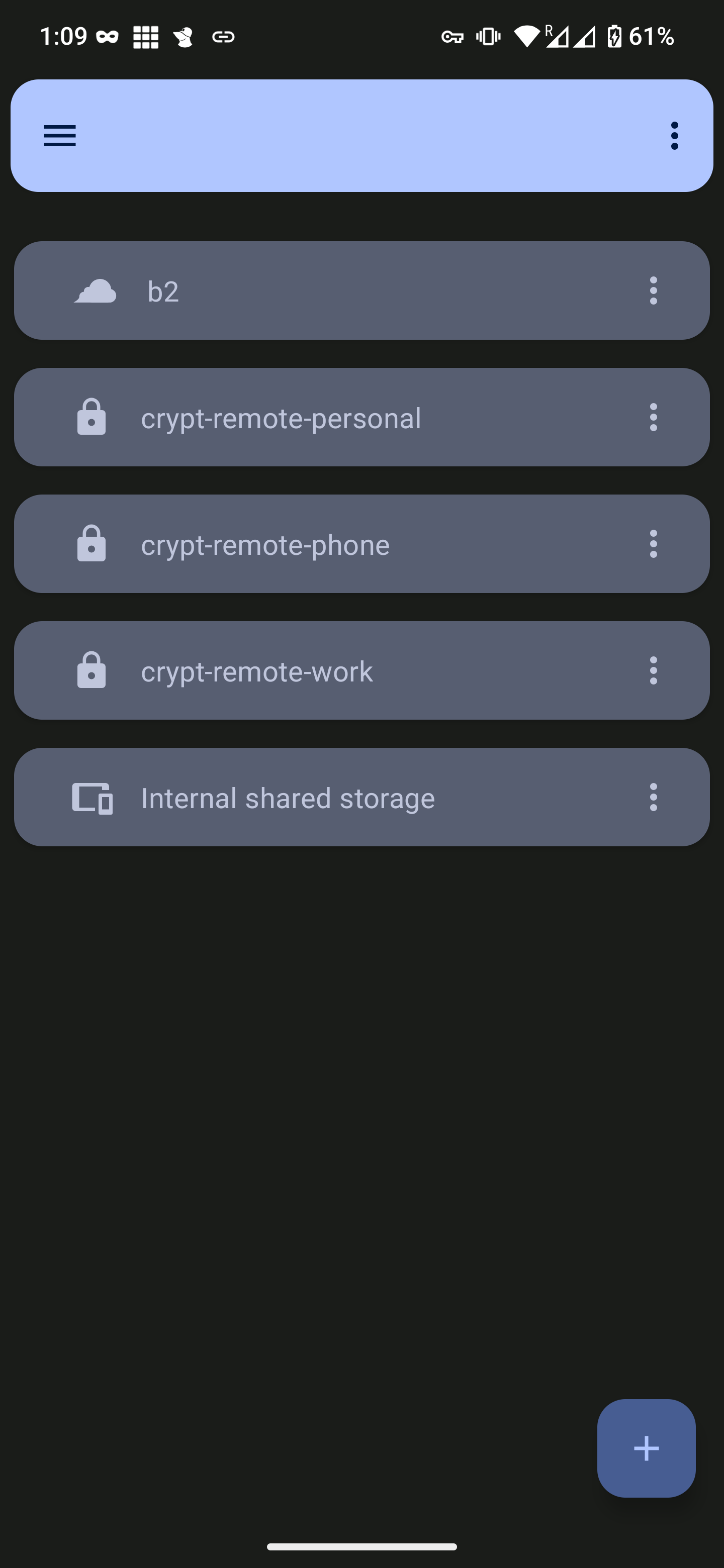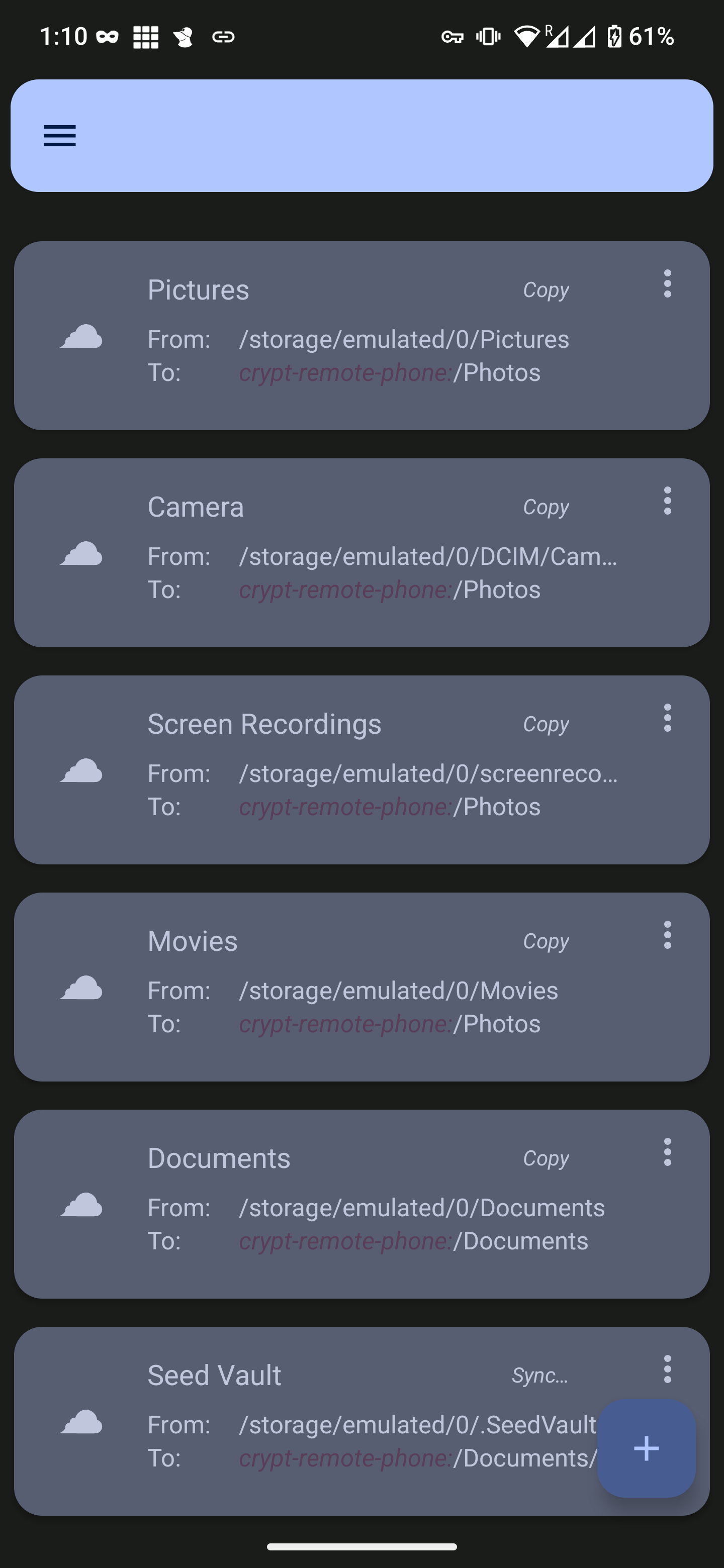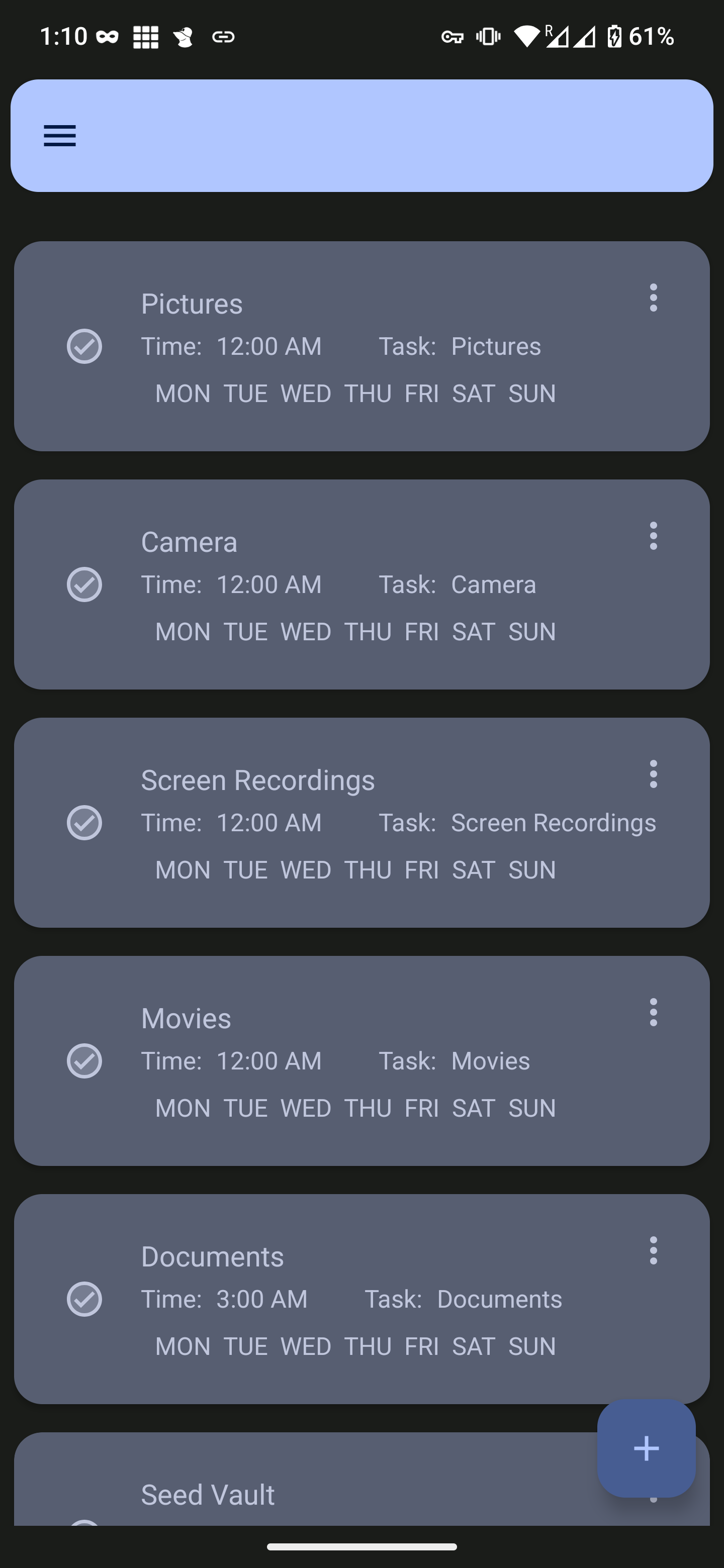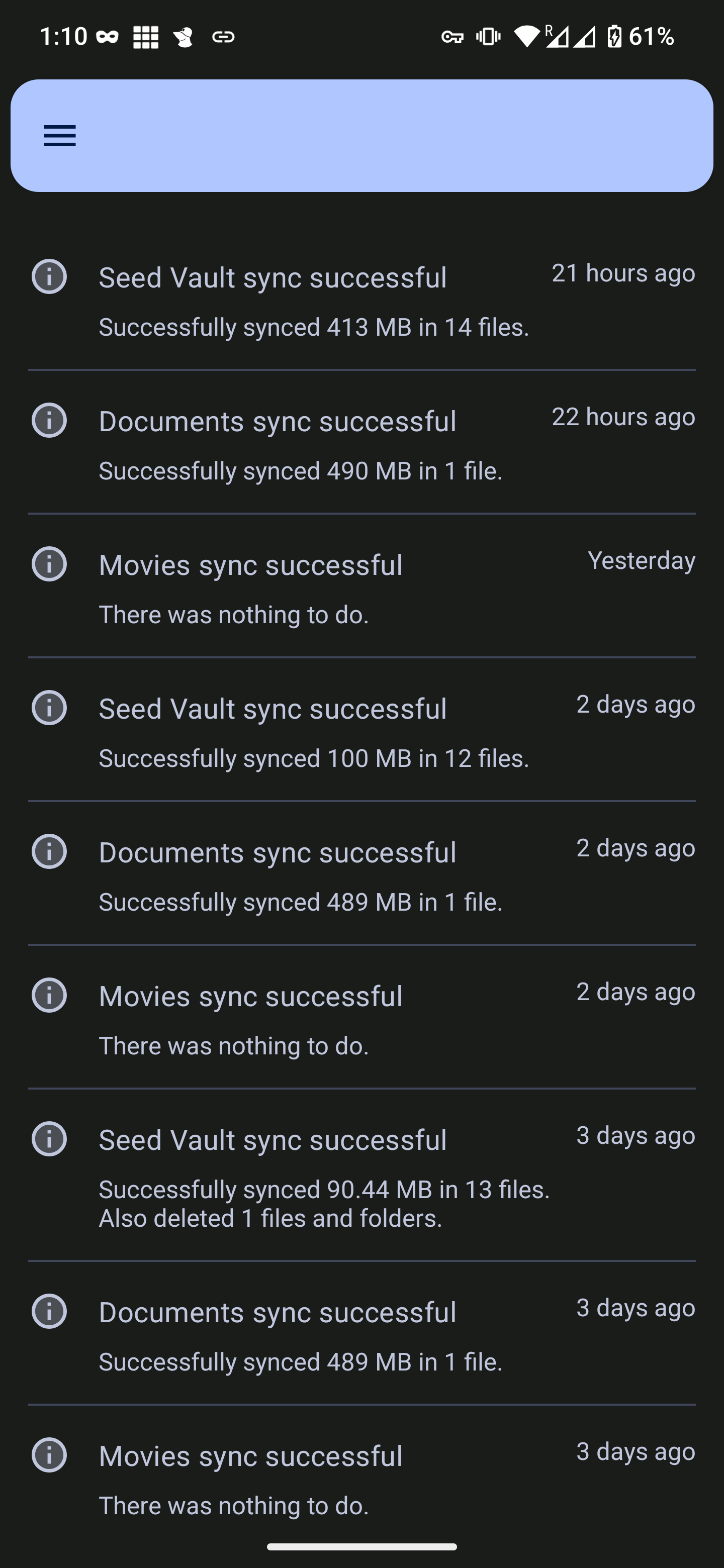

You are correct, fixed!


You are correct, fixed!


https://github.com/newhinton/Round-Sync. Not in any app store and have to download and install from GitHub.
It is an Android wrapper around rsync rclone.
Setup a remote, setup tasks, and setup triggers. Mine syncs every night. It supports encrypting with your own keys. Large number of remotes supported from self-hosted to cloud.






They can modify the DNS packets still. They aren’t encrypted or signed so the authenticity of a response packet cannot be verified. Parental controls from ISP relay on being able to snoop and modify your DNS (and SNI from TLS ClientHello packets).


LazyVim. Didn’t have time to do everything manually when I wanted to cut over from regular vim. I have quite a few customizations on top, but its a pretty solid base. I use with neovim nightly via nixos.


Immutable Nixos. My entire server deployment from partitioning to config is stored in git on all my machines.
Every time I boot all runtime changes are “wiped”, which is really just BTRFS subvolume swapping.
Persistence is possible, but I’m forced to deal with it otherwise it will get wiped on boot.
I use LVM for mirrored volumes for local redundancy.
My persisted volumes are backed up automatically to B2 Backblaze using rclone. I don’t backup everything. Stuff I can download again are skipped for example. I don’t have anything currently that requires putting a process in “maint mode” like a database getting corrupt if I backup while its being written to. When I did, I’d either script gracefully shutting down the process or use any export functionality if the process supported it.


Don’t Look Up!


I use rclone and the Round Sync Android client.
Supports a ton of back ends, self hosted, and commercial options. You can transparently encrypt with private keys you control.
I personally use B2 Backblaze for storage.
My phone backs up every night and Round Sync pushes them to B2. On my desktop I can mount as a volume. I can also access my storage from my phone going the other direction.
I’ve done the same using SFTP if I don’t want the overhead of persistent file storage.
It does not support indexing or previews for searching or finding say a photo. You can put whatever you want for data. So I have caches, indexes, and thumbnails that work in Linux. I can’t really make use of those on my phone though.
Rclones bisync feature is also a bit dangerous when I tried to use it a year ago. I more than once “deleted” everything. B2 doesn’t delete by default, just hides, so I was able to recover. I now do unidirectional syncs from my machines to different buckets until I’m motivated to investigate a proper 3-way merge solution.


This is news to me. That said, I’m usually one generation behind but upgrade every 2 years as my phone is usually EOL for software updates by the end of the period. I try to time it so I can get a replacement paid outright at mid-range prices.
With the Pixel 8 introducing extended software support, I’ll have to dig more into this.


I’m on Graphene. Mullvad is only 1% for me with 16h30min since last on a charge. I’m at 56% with 1h30m screen time.
I used GPS as I did some driving with maps and my music app accounting for 29% of my battery usage.
I throw my phone on the charger at night figuring battery tech and software management is good enough.
Are you WiFi or mobile? I get shitty mobile service so if I’m off WiFi my battery tends to go to shit. The VPN usually accounts for more as I assume it keeps reconnecting.


Has not worked for me in ages on Graphene. Same issue. It quits right away. Even tried messing with the hardened malloc and it was no go. Been a pain trying to use Zelle or deposit checks. Other than a handful of core apps I just use the web mostly at this point.


Oh nice! I’ll have to dig into that. Wonder if its an implementation issue across vendors. I was always under the impression that DHCPv6 was the common convention if not static.


Ok. So a device didn’t get a dhcp address? No problem… It creates it’s open IP address and starts talking and try to get out on internet on its own…
Its not that different from a conceptual point of view. Your router is still the gate keeper.
Home router to ISP will usually use DHCPv6 to get a prefix. Sizes vary by ISP but its usually like a /64. This is done with Prefix Delegation.
Client to Home Router will use either SLACC, DHCPv6, or both.
SLACC uses ICMPv6 where the client asks for the prefix (Router Solicitation) and the router advertises the prefix (Router Advertisement) and the client picks an address in it. There is some duplication protection for clients picking the same IP, but its nothing you have to configure. Conceptually its not that different from DHCP Request/Offer. The clients cannot just get to the internet on their own.
SLACC doesn’t support sending stuff like DNS servers. So DHCPv6 may still be used to get that information, but not an assigned IP.
Just DHCPv6 can also be used, but SLACC has the feature of being stateless. No leases or anything.
The only other nuance worth calling out is interfaces will pick a link local address so it can talk to the devices its directly connected to over layer 3 instead of just layer 2. This is no different than configuring 169.254.1.10/31 on one side and 169.254.1.11/31 on the other. These are not routed, its just for two connected devices to send packets to each other. This with Neighbor Discovery fills the role of ARP.
There is a whole bunch more to IPv6, but for a typical home network these analogies pretty much cover what you’d use.


Very happy. My two daily drivers (Desktop and Laptop) are on Ubuntu but user space is managed with Nix.
All other machines are Nixos proper. Only thing keeping me back from moving to Nixos fully is I decided to piecemeal my own DE and I’ve just lacked the time to debug some issues related to gnome-keyring, computer locking, and coding up some system setting widgets.


I don’t know about Nvidia specifically, but I mostly only see RSUs offered to Staff/Principal level engineers or Director and above on the management track. Many times with a multi year vestment period to act as a retention tool. You can make out good at the exiting end of the deal.
IMHO its a shitty practice. There is risk if the C-level pulls some stupid shit tanking the stock. The reward could just as easily be distributed to employees with a profit sharing bonus that eliminates the risk of my options tanking while vesting. Let the employees convert to options if they want to stake on future company performance.
At least in the US, I could have used the value of my options earlier in life to help with student loans, buying a house, medical issues, having kids, etc. I grew up poor. I “pulled myself up from bootstraps” and am doing well now. I still think the whole system is a dumb gimmick.


While I have nothing against an arch recommendation, I wouldn’t rely on my distro when there is tooling to get any version of a library directly from pypi.


Having done some MQTT IoT work in the past, dropping a couple resources:
https://github.com/eclipse/mosquitto - CLI interface and C bindings. I’ve only used the CLI interface. Its a nice way to test communication with a remote broker.
RabbitMQ /w MQTT plugin - Message queue based on AMQP. We ran this as the server in a container. There maybe others options like 0MQ (been a few years so don’t know every option). I had my clients post to a wild card topic so that I could consume a single device or all devices. Consumption is not with MQTT though. We’d use AMQP on that side.


I recommended checking out package managers that will simplify using whatever version of a library you want with project level virtual environments.
I haven’t done heavy python dev since 3.7, so I don’t know the full landscape of options these days, but here are some references to dig into.
https://python-poetry.org/ is the one I started using as the first step up from pip.
It looks like there are some new contenders like hatch, rye, and pdm: https://dev.to/adamghill/python-package-manager-comparison-1g98.
There is also pixi referenced from the comments in that article: https://github.com/prefix-dev/pixi


Try clicking on the encrypted partition to get the passphrase option.
https://askubuntu.com/questions/95137/how-to-change-luks-passphrase


I haven’t tested in Windows, but this is my setup Linux to Linux using rclone which the docs say works with Windows.
Server
Client
I use this setup for my local files and a similar setup to my Backblaze B2 off site backups.
The VFS implementation has been pretty good. You can also manually sync. Their bisync I don’t fully trust though.
I can access everything through android using https://github.com/newhinton/Round-Sync. Not great for photos though as thumbnails weren’t loading without pulling the whole file last I tested a year ago.
Yeah I don’t want locally deleted media (to free up space) to sync those deletions to my remote.
My crypted remotes wrap a B2 Backblaze one which doesn’t delete, just hides. Periodically I go clean it up.